In-Depth Analysis: Management Consulting Services and Business
VerifiedAdded on 2023/05/04
|14
|3860
|109
Report
AI Summary
This report provides a comprehensive overview of management consulting, detailing its functions, roles, and interactions. It begins by defining management consulting and outlining managerial functions such as planning, organizing, staffing, directing, and controlling. The report further examines managerial roles, including interpersonal, informational, and decisional roles, emphasizing the importance of leadership and communication. Client-consultant interactions are explored through supplementing, complementing, differentiating, integrating, and enhancing processes. The responsibilities of management consultants, including economic, legal, moral, and discretionary aspects, are discussed, along with various types of clients, such as contact, intermediate, primary, unwitting, indirect, and ultimate clients. Different modes of consulting, including the expert mode, doctor-patient mode, and process consulting mode, are analyzed. The report also addresses the reasons for business failure and strategies for planning against it, highlighting the role of consulting in business growth and strategic processes. Finally, it touches on marketing research, sales, finance, new product development, and both hard and soft side consulting, including operations management, IT management, human resources, and organizational development.
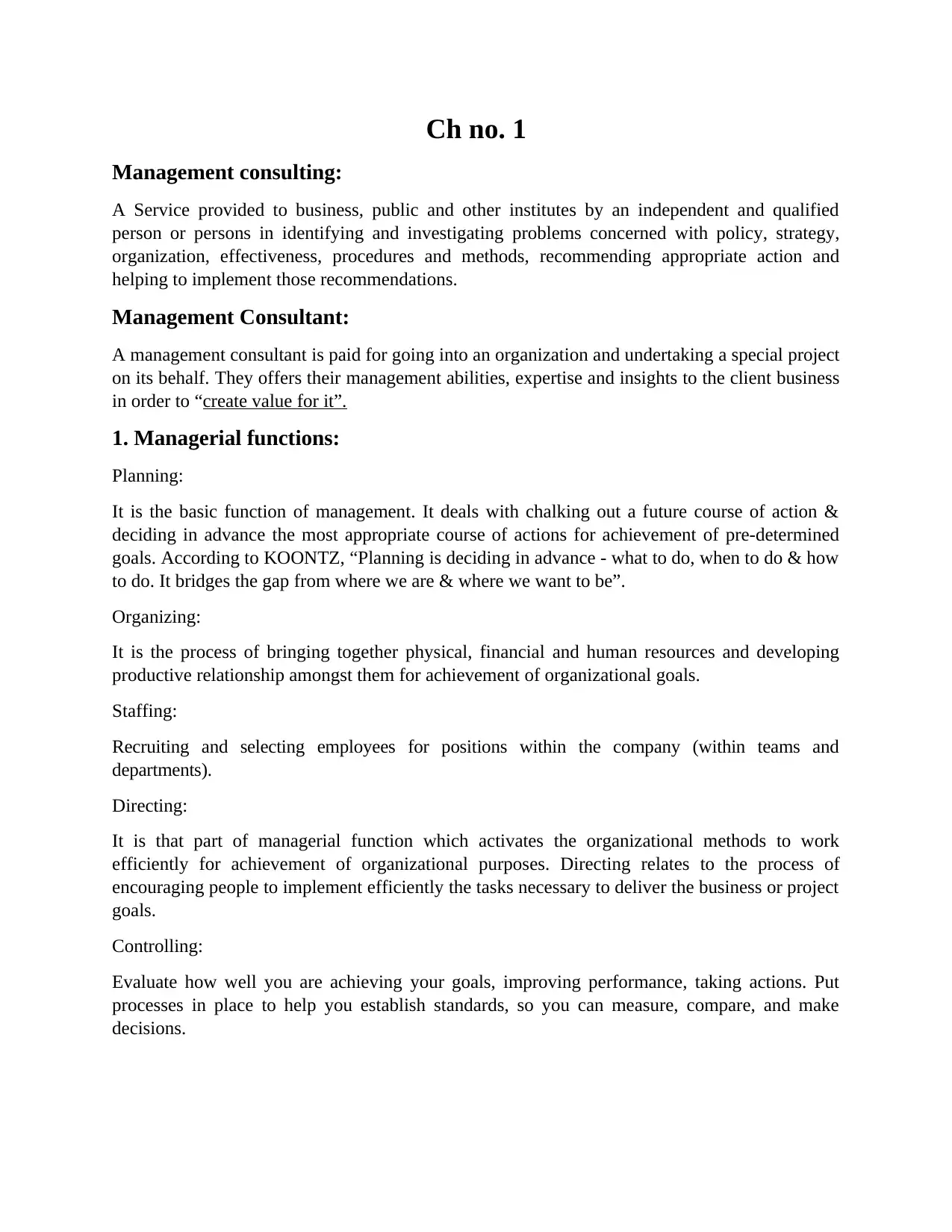
Ch no. 1
Management consulting:
A Service provided to business, public and other institutes by an independent and qualified
person or persons in identifying and investigating problems concerned with policy, strategy,
organization, effectiveness, procedures and methods, recommending appropriate action and
helping to implement those recommendations.
Management Consultant:
A management consultant is paid for going into an organization and undertaking a special project
on its behalf. They offers their management abilities, expertise and insights to the client business
in order to “create value for it”.
1. Managerial functions:
Planning:
It is the basic function of management. It deals with chalking out a future course of action &
deciding in advance the most appropriate course of actions for achievement of pre-determined
goals. According to KOONTZ, “Planning is deciding in advance - what to do, when to do & how
to do. It bridges the gap from where we are & where we want to be”.
Organizing:
It is the process of bringing together physical, financial and human resources and developing
productive relationship amongst them for achievement of organizational goals.
Staffing:
Recruiting and selecting employees for positions within the company (within teams and
departments).
Directing:
It is that part of managerial function which activates the organizational methods to work
efficiently for achievement of organizational purposes. Directing relates to the process of
encouraging people to implement efficiently the tasks necessary to deliver the business or project
goals.
Controlling:
Evaluate how well you are achieving your goals, improving performance, taking actions. Put
processes in place to help you establish standards, so you can measure, compare, and make
decisions.
Management consulting:
A Service provided to business, public and other institutes by an independent and qualified
person or persons in identifying and investigating problems concerned with policy, strategy,
organization, effectiveness, procedures and methods, recommending appropriate action and
helping to implement those recommendations.
Management Consultant:
A management consultant is paid for going into an organization and undertaking a special project
on its behalf. They offers their management abilities, expertise and insights to the client business
in order to “create value for it”.
1. Managerial functions:
Planning:
It is the basic function of management. It deals with chalking out a future course of action &
deciding in advance the most appropriate course of actions for achievement of pre-determined
goals. According to KOONTZ, “Planning is deciding in advance - what to do, when to do & how
to do. It bridges the gap from where we are & where we want to be”.
Organizing:
It is the process of bringing together physical, financial and human resources and developing
productive relationship amongst them for achievement of organizational goals.
Staffing:
Recruiting and selecting employees for positions within the company (within teams and
departments).
Directing:
It is that part of managerial function which activates the organizational methods to work
efficiently for achievement of organizational purposes. Directing relates to the process of
encouraging people to implement efficiently the tasks necessary to deliver the business or project
goals.
Controlling:
Evaluate how well you are achieving your goals, improving performance, taking actions. Put
processes in place to help you establish standards, so you can measure, compare, and make
decisions.
Paraphrase This Document
Need a fresh take? Get an instant paraphrase of this document with our AI Paraphraser
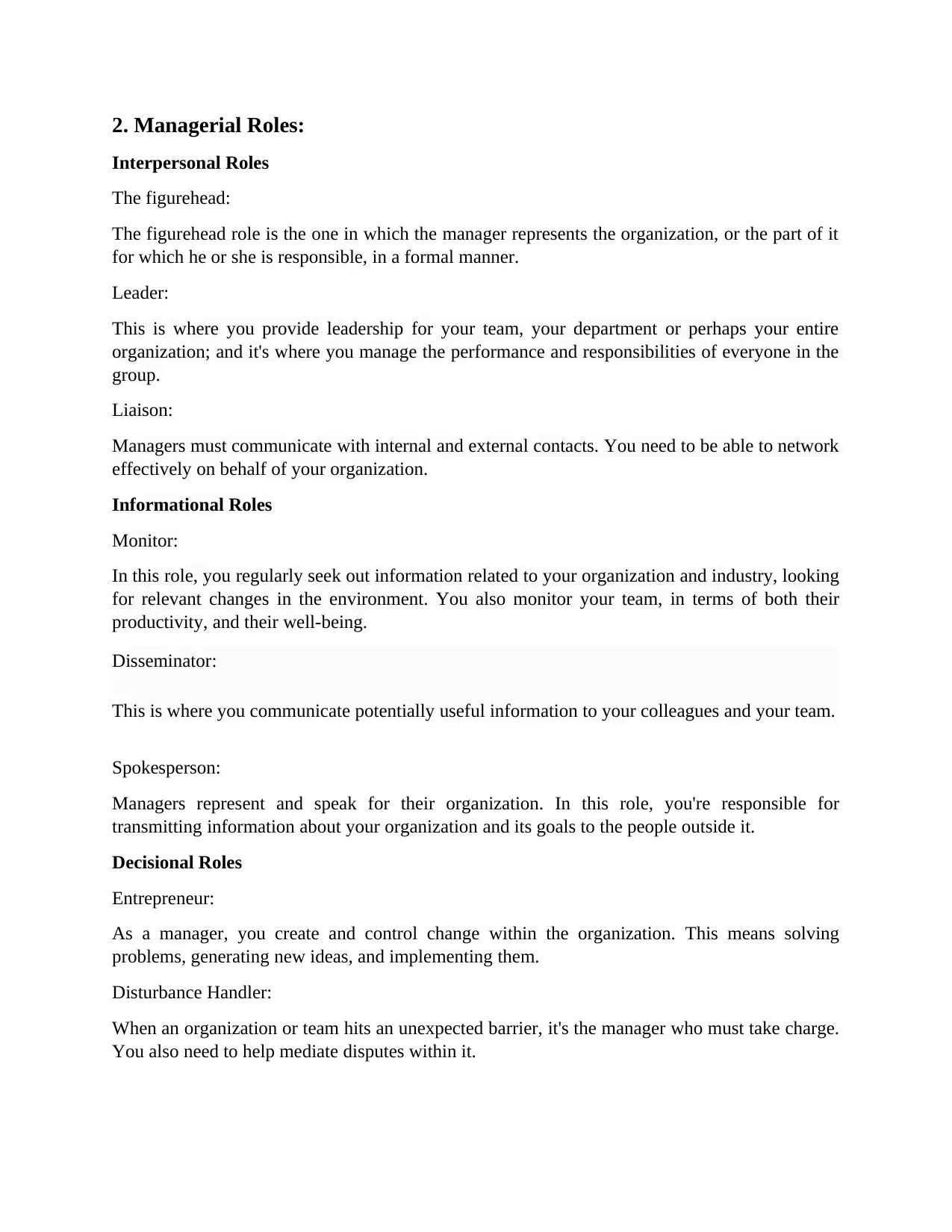
2. Managerial Roles:
Interpersonal Roles
The figurehead:
The figurehead role is the one in which the manager represents the organization, or the part of it
for which he or she is responsible, in a formal manner.
Leader:
This is where you provide leadership for your team, your department or perhaps your entire
organization; and it's where you manage the performance and responsibilities of everyone in the
group.
Liaison:
Managers must communicate with internal and external contacts. You need to be able to network
effectively on behalf of your organization.
Informational Roles
Monitor:
In this role, you regularly seek out information related to your organization and industry, looking
for relevant changes in the environment. You also monitor your team, in terms of both their
productivity, and their well-being.
Disseminator:
This is where you communicate potentially useful information to your colleagues and your team.
Spokesperson:
Managers represent and speak for their organization. In this role, you're responsible for
transmitting information about your organization and its goals to the people outside it.
Decisional Roles
Entrepreneur:
As a manager, you create and control change within the organization. This means solving
problems, generating new ideas, and implementing them.
Disturbance Handler:
When an organization or team hits an unexpected barrier, it's the manager who must take charge.
You also need to help mediate disputes within it.
Interpersonal Roles
The figurehead:
The figurehead role is the one in which the manager represents the organization, or the part of it
for which he or she is responsible, in a formal manner.
Leader:
This is where you provide leadership for your team, your department or perhaps your entire
organization; and it's where you manage the performance and responsibilities of everyone in the
group.
Liaison:
Managers must communicate with internal and external contacts. You need to be able to network
effectively on behalf of your organization.
Informational Roles
Monitor:
In this role, you regularly seek out information related to your organization and industry, looking
for relevant changes in the environment. You also monitor your team, in terms of both their
productivity, and their well-being.
Disseminator:
This is where you communicate potentially useful information to your colleagues and your team.
Spokesperson:
Managers represent and speak for their organization. In this role, you're responsible for
transmitting information about your organization and its goals to the people outside it.
Decisional Roles
Entrepreneur:
As a manager, you create and control change within the organization. This means solving
problems, generating new ideas, and implementing them.
Disturbance Handler:
When an organization or team hits an unexpected barrier, it's the manager who must take charge.
You also need to help mediate disputes within it.
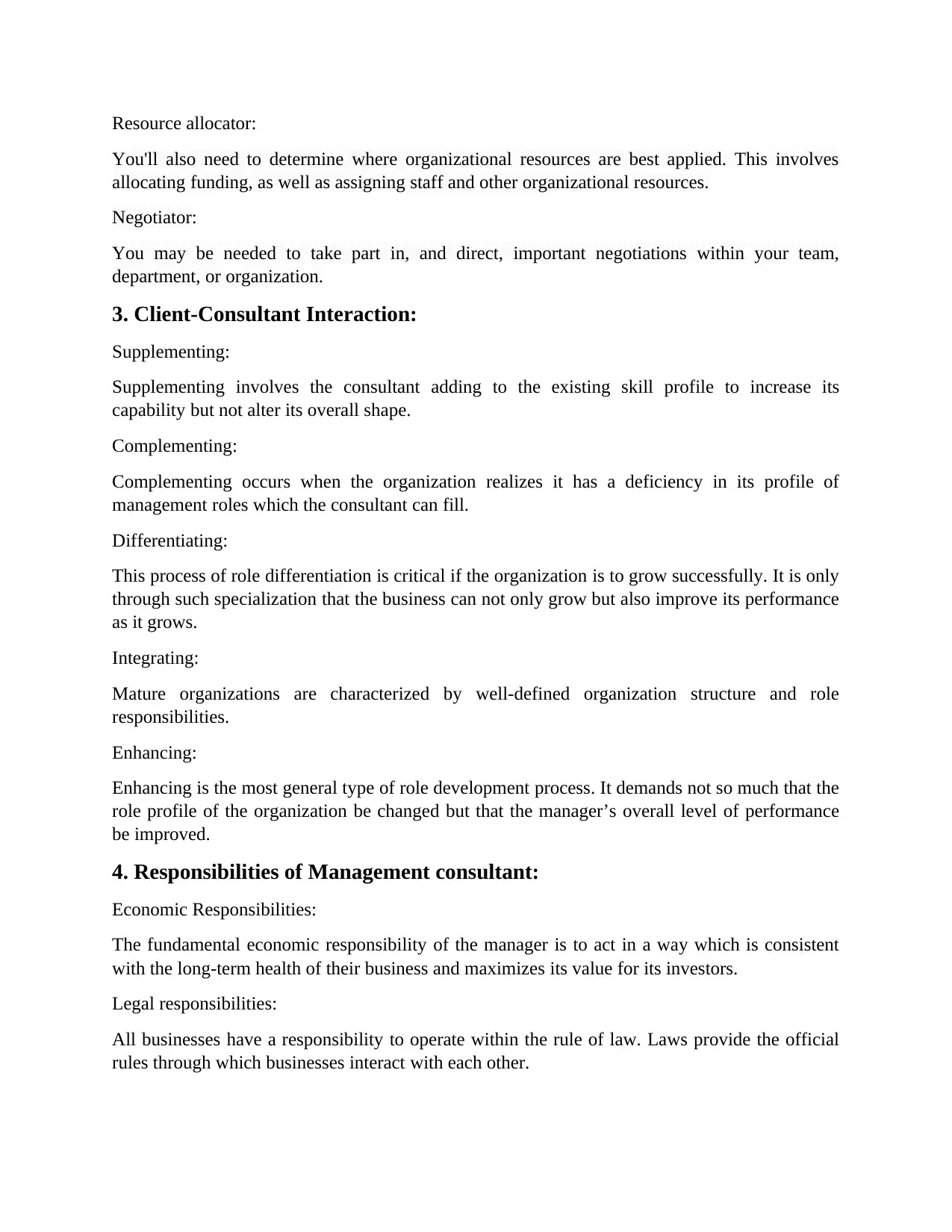
Resource allocator:
You'll also need to determine where organizational resources are best applied. This involves
allocating funding, as well as assigning staff and other organizational resources.
Negotiator:
You may be needed to take part in, and direct, important negotiations within your team,
department, or organization.
3. Client-Consultant Interaction:
Supplementing:
Supplementing involves the consultant adding to the existing skill profile to increase its
capability but not alter its overall shape.
Complementing:
Complementing occurs when the organization realizes it has a deficiency in its profile of
management roles which the consultant can fill.
Differentiating:
This process of role differentiation is critical if the organization is to grow successfully. It is only
through such specialization that the business can not only grow but also improve its performance
as it grows.
Integrating:
Mature organizations are characterized by well-defined organization structure and role
responsibilities.
Enhancing:
Enhancing is the most general type of role development process. It demands not so much that the
role profile of the organization be changed but that the manager’s overall level of performance
be improved.
4. Responsibilities of Management consultant:
Economic Responsibilities:
The fundamental economic responsibility of the manager is to act in a way which is consistent
with the long-term health of their business and maximizes its value for its investors.
Legal responsibilities:
All businesses have a responsibility to operate within the rule of law. Laws provide the official
rules through which businesses interact with each other.
You'll also need to determine where organizational resources are best applied. This involves
allocating funding, as well as assigning staff and other organizational resources.
Negotiator:
You may be needed to take part in, and direct, important negotiations within your team,
department, or organization.
3. Client-Consultant Interaction:
Supplementing:
Supplementing involves the consultant adding to the existing skill profile to increase its
capability but not alter its overall shape.
Complementing:
Complementing occurs when the organization realizes it has a deficiency in its profile of
management roles which the consultant can fill.
Differentiating:
This process of role differentiation is critical if the organization is to grow successfully. It is only
through such specialization that the business can not only grow but also improve its performance
as it grows.
Integrating:
Mature organizations are characterized by well-defined organization structure and role
responsibilities.
Enhancing:
Enhancing is the most general type of role development process. It demands not so much that the
role profile of the organization be changed but that the manager’s overall level of performance
be improved.
4. Responsibilities of Management consultant:
Economic Responsibilities:
The fundamental economic responsibility of the manager is to act in a way which is consistent
with the long-term health of their business and maximizes its value for its investors.
Legal responsibilities:
All businesses have a responsibility to operate within the rule of law. Laws provide the official
rules through which businesses interact with each other.
⊘ This is a preview!⊘
Do you want full access?
Subscribe today to unlock all pages.

Trusted by 1+ million students worldwide
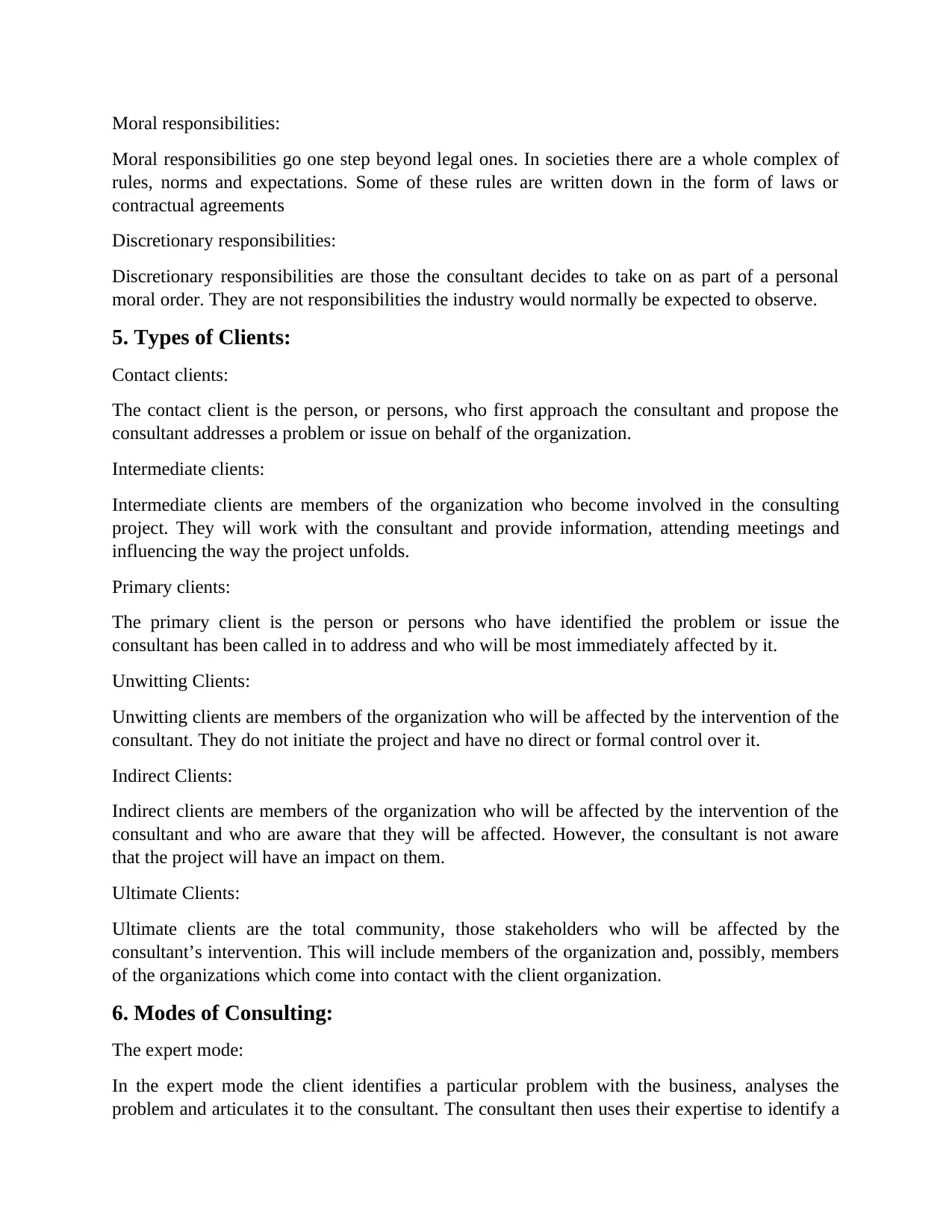
Moral responsibilities:
Moral responsibilities go one step beyond legal ones. In societies there are a whole complex of
rules, norms and expectations. Some of these rules are written down in the form of laws or
contractual agreements
Discretionary responsibilities:
Discretionary responsibilities are those the consultant decides to take on as part of a personal
moral order. They are not responsibilities the industry would normally be expected to observe.
5. Types of Clients:
Contact clients:
The contact client is the person, or persons, who first approach the consultant and propose the
consultant addresses a problem or issue on behalf of the organization.
Intermediate clients:
Intermediate clients are members of the organization who become involved in the consulting
project. They will work with the consultant and provide information, attending meetings and
influencing the way the project unfolds.
Primary clients:
The primary client is the person or persons who have identified the problem or issue the
consultant has been called in to address and who will be most immediately affected by it.
Unwitting Clients:
Unwitting clients are members of the organization who will be affected by the intervention of the
consultant. They do not initiate the project and have no direct or formal control over it.
Indirect Clients:
Indirect clients are members of the organization who will be affected by the intervention of the
consultant and who are aware that they will be affected. However, the consultant is not aware
that the project will have an impact on them.
Ultimate Clients:
Ultimate clients are the total community, those stakeholders who will be affected by the
consultant’s intervention. This will include members of the organization and, possibly, members
of the organizations which come into contact with the client organization.
6. Modes of Consulting:
The expert mode:
In the expert mode the client identifies a particular problem with the business, analyses the
problem and articulates it to the consultant. The consultant then uses their expertise to identify a
Moral responsibilities go one step beyond legal ones. In societies there are a whole complex of
rules, norms and expectations. Some of these rules are written down in the form of laws or
contractual agreements
Discretionary responsibilities:
Discretionary responsibilities are those the consultant decides to take on as part of a personal
moral order. They are not responsibilities the industry would normally be expected to observe.
5. Types of Clients:
Contact clients:
The contact client is the person, or persons, who first approach the consultant and propose the
consultant addresses a problem or issue on behalf of the organization.
Intermediate clients:
Intermediate clients are members of the organization who become involved in the consulting
project. They will work with the consultant and provide information, attending meetings and
influencing the way the project unfolds.
Primary clients:
The primary client is the person or persons who have identified the problem or issue the
consultant has been called in to address and who will be most immediately affected by it.
Unwitting Clients:
Unwitting clients are members of the organization who will be affected by the intervention of the
consultant. They do not initiate the project and have no direct or formal control over it.
Indirect Clients:
Indirect clients are members of the organization who will be affected by the intervention of the
consultant and who are aware that they will be affected. However, the consultant is not aware
that the project will have an impact on them.
Ultimate Clients:
Ultimate clients are the total community, those stakeholders who will be affected by the
consultant’s intervention. This will include members of the organization and, possibly, members
of the organizations which come into contact with the client organization.
6. Modes of Consulting:
The expert mode:
In the expert mode the client identifies a particular problem with the business, analyses the
problem and articulates it to the consultant. The consultant then uses their expertise to identify a
Paraphrase This Document
Need a fresh take? Get an instant paraphrase of this document with our AI Paraphraser
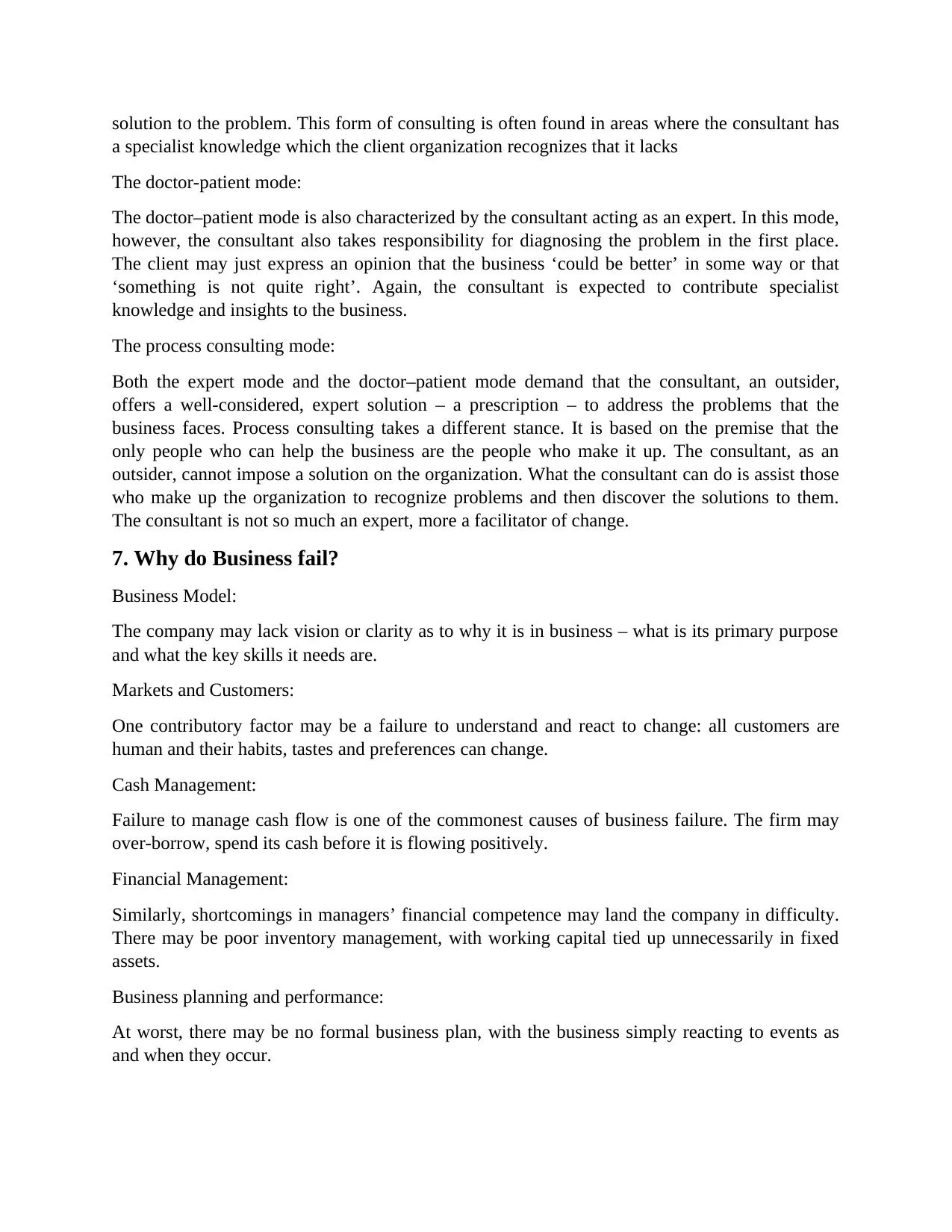
solution to the problem. This form of consulting is often found in areas where the consultant has
a specialist knowledge which the client organization recognizes that it lacks
The doctor-patient mode:
The doctor–patient mode is also characterized by the consultant acting as an expert. In this mode,
however, the consultant also takes responsibility for diagnosing the problem in the first place.
The client may just express an opinion that the business ‘could be better’ in some way or that
‘something is not quite right’. Again, the consultant is expected to contribute specialist
knowledge and insights to the business.
The process consulting mode:
Both the expert mode and the doctor–patient mode demand that the consultant, an outsider,
offers a well-considered, expert solution – a prescription – to address the problems that the
business faces. Process consulting takes a different stance. It is based on the premise that the
only people who can help the business are the people who make it up. The consultant, as an
outsider, cannot impose a solution on the organization. What the consultant can do is assist those
who make up the organization to recognize problems and then discover the solutions to them.
The consultant is not so much an expert, more a facilitator of change.
7. Why do Business fail?
Business Model:
The company may lack vision or clarity as to why it is in business – what is its primary purpose
and what the key skills it needs are.
Markets and Customers:
One contributory factor may be a failure to understand and react to change: all customers are
human and their habits, tastes and preferences can change.
Cash Management:
Failure to manage cash flow is one of the commonest causes of business failure. The firm may
over-borrow, spend its cash before it is flowing positively.
Financial Management:
Similarly, shortcomings in managers’ financial competence may land the company in difficulty.
There may be poor inventory management, with working capital tied up unnecessarily in fixed
assets.
Business planning and performance:
At worst, there may be no formal business plan, with the business simply reacting to events as
and when they occur.
a specialist knowledge which the client organization recognizes that it lacks
The doctor-patient mode:
The doctor–patient mode is also characterized by the consultant acting as an expert. In this mode,
however, the consultant also takes responsibility for diagnosing the problem in the first place.
The client may just express an opinion that the business ‘could be better’ in some way or that
‘something is not quite right’. Again, the consultant is expected to contribute specialist
knowledge and insights to the business.
The process consulting mode:
Both the expert mode and the doctor–patient mode demand that the consultant, an outsider,
offers a well-considered, expert solution – a prescription – to address the problems that the
business faces. Process consulting takes a different stance. It is based on the premise that the
only people who can help the business are the people who make it up. The consultant, as an
outsider, cannot impose a solution on the organization. What the consultant can do is assist those
who make up the organization to recognize problems and then discover the solutions to them.
The consultant is not so much an expert, more a facilitator of change.
7. Why do Business fail?
Business Model:
The company may lack vision or clarity as to why it is in business – what is its primary purpose
and what the key skills it needs are.
Markets and Customers:
One contributory factor may be a failure to understand and react to change: all customers are
human and their habits, tastes and preferences can change.
Cash Management:
Failure to manage cash flow is one of the commonest causes of business failure. The firm may
over-borrow, spend its cash before it is flowing positively.
Financial Management:
Similarly, shortcomings in managers’ financial competence may land the company in difficulty.
There may be poor inventory management, with working capital tied up unnecessarily in fixed
assets.
Business planning and performance:
At worst, there may be no formal business plan, with the business simply reacting to events as
and when they occur.
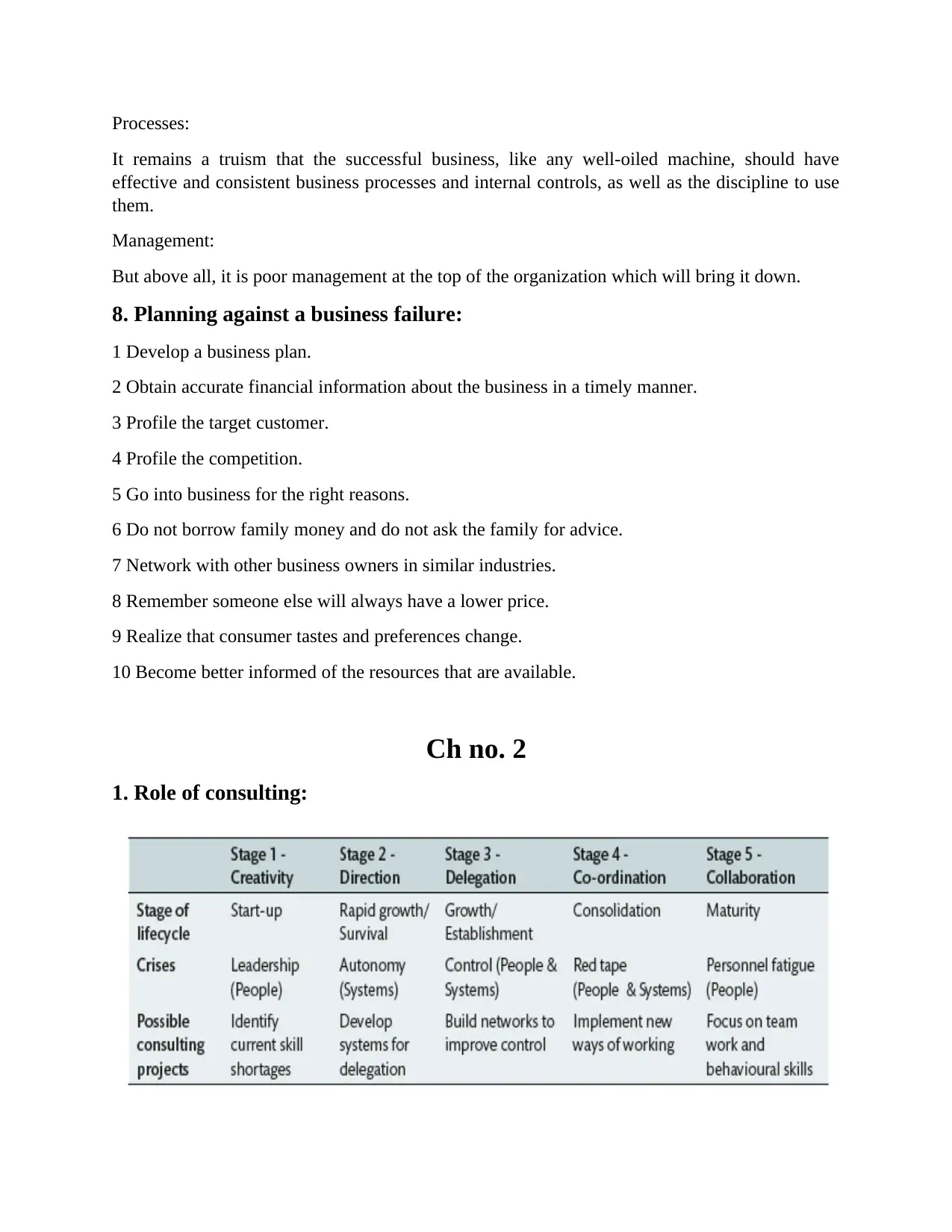
Processes:
It remains a truism that the successful business, like any well-oiled machine, should have
effective and consistent business processes and internal controls, as well as the discipline to use
them.
Management:
But above all, it is poor management at the top of the organization which will bring it down.
8. Planning against a business failure:
1 Develop a business plan.
2 Obtain accurate financial information about the business in a timely manner.
3 Profile the target customer.
4 Profile the competition.
5 Go into business for the right reasons.
6 Do not borrow family money and do not ask the family for advice.
7 Network with other business owners in similar industries.
8 Remember someone else will always have a lower price.
9 Realize that consumer tastes and preferences change.
10 Become better informed of the resources that are available.
Ch no. 2
1. Role of consulting:
It remains a truism that the successful business, like any well-oiled machine, should have
effective and consistent business processes and internal controls, as well as the discipline to use
them.
Management:
But above all, it is poor management at the top of the organization which will bring it down.
8. Planning against a business failure:
1 Develop a business plan.
2 Obtain accurate financial information about the business in a timely manner.
3 Profile the target customer.
4 Profile the competition.
5 Go into business for the right reasons.
6 Do not borrow family money and do not ask the family for advice.
7 Network with other business owners in similar industries.
8 Remember someone else will always have a lower price.
9 Realize that consumer tastes and preferences change.
10 Become better informed of the resources that are available.
Ch no. 2
1. Role of consulting:
⊘ This is a preview!⊘
Do you want full access?
Subscribe today to unlock all pages.

Trusted by 1+ million students worldwide
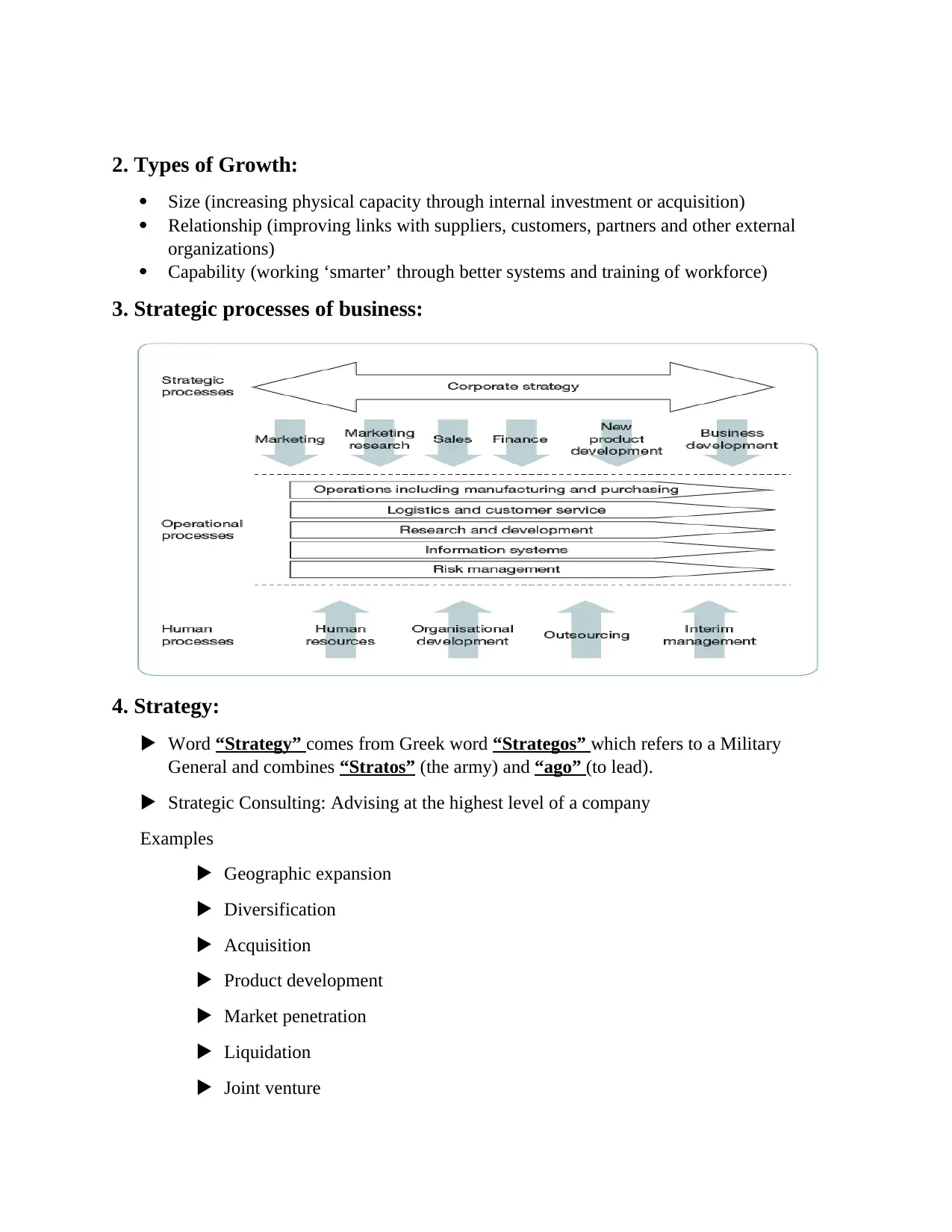
2. Types of Growth:
Size (increasing physical capacity through internal investment or acquisition)
Relationship (improving links with suppliers, customers, partners and other external
organizations)
Capability (working ‘smarter’ through better systems and training of workforce)
3. Strategic processes of business:
4. Strategy:
Word “Strategy” comes from Greek word “Strategos” which refers to a Military
General and combines “Stratos” (the army) and “ago” (to lead).
Strategic Consulting: Advising at the highest level of a company
Examples
Geographic expansion
Diversification
Acquisition
Product development
Market penetration
Liquidation
Joint venture
Size (increasing physical capacity through internal investment or acquisition)
Relationship (improving links with suppliers, customers, partners and other external
organizations)
Capability (working ‘smarter’ through better systems and training of workforce)
3. Strategic processes of business:
4. Strategy:
Word “Strategy” comes from Greek word “Strategos” which refers to a Military
General and combines “Stratos” (the army) and “ago” (to lead).
Strategic Consulting: Advising at the highest level of a company
Examples
Geographic expansion
Diversification
Acquisition
Product development
Market penetration
Liquidation
Joint venture
Paraphrase This Document
Need a fresh take? Get an instant paraphrase of this document with our AI Paraphraser
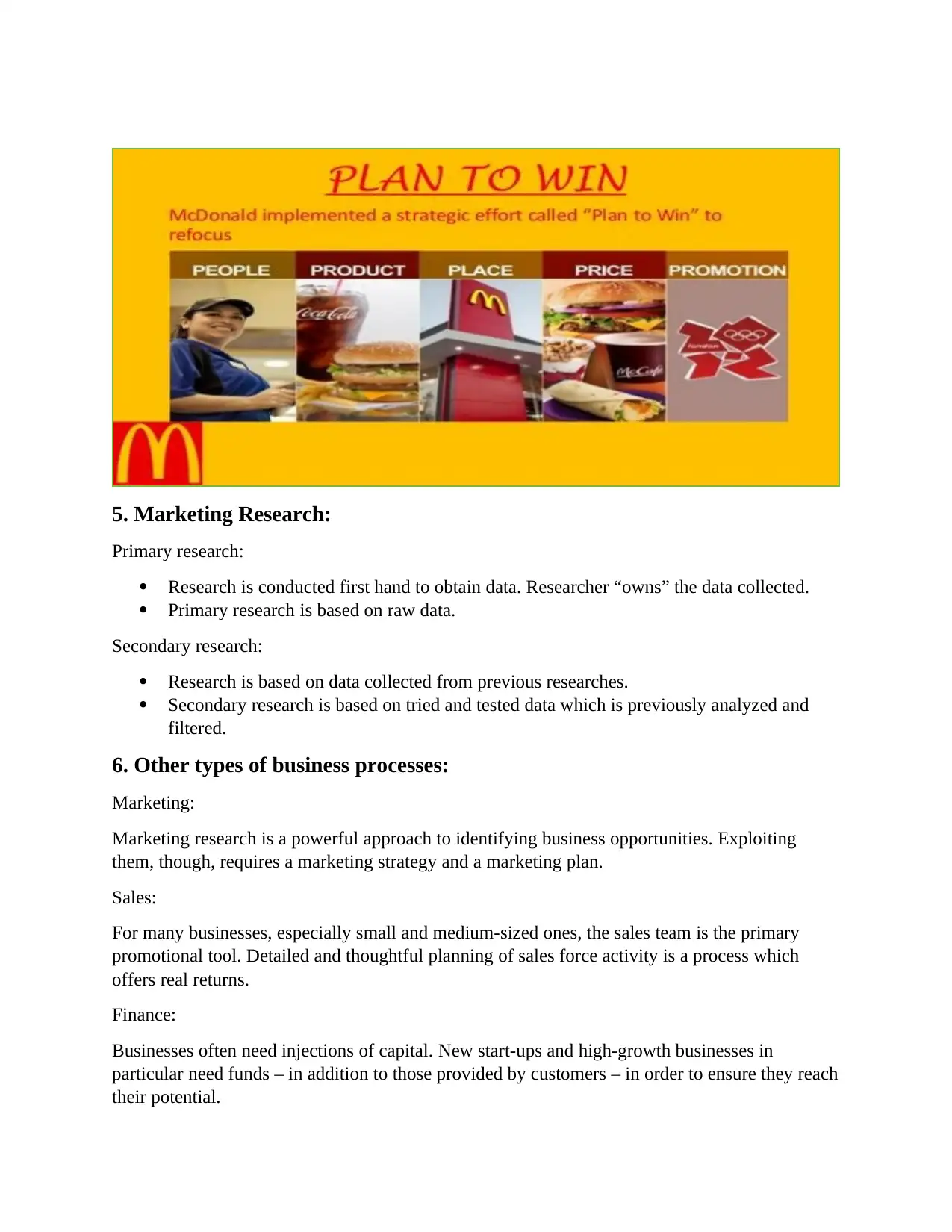
5. Marketing Research:
Primary research:
Research is conducted first hand to obtain data. Researcher “owns” the data collected.
Primary research is based on raw data.
Secondary research:
Research is based on data collected from previous researches.
Secondary research is based on tried and tested data which is previously analyzed and
filtered.
6. Other types of business processes:
Marketing:
Marketing research is a powerful approach to identifying business opportunities. Exploiting
them, though, requires a marketing strategy and a marketing plan.
Sales:
For many businesses, especially small and medium-sized ones, the sales team is the primary
promotional tool. Detailed and thoughtful planning of sales force activity is a process which
offers real returns.
Finance:
Businesses often need injections of capital. New start-ups and high-growth businesses in
particular need funds – in addition to those provided by customers – in order to ensure they reach
their potential.
Primary research:
Research is conducted first hand to obtain data. Researcher “owns” the data collected.
Primary research is based on raw data.
Secondary research:
Research is based on data collected from previous researches.
Secondary research is based on tried and tested data which is previously analyzed and
filtered.
6. Other types of business processes:
Marketing:
Marketing research is a powerful approach to identifying business opportunities. Exploiting
them, though, requires a marketing strategy and a marketing plan.
Sales:
For many businesses, especially small and medium-sized ones, the sales team is the primary
promotional tool. Detailed and thoughtful planning of sales force activity is a process which
offers real returns.
Finance:
Businesses often need injections of capital. New start-ups and high-growth businesses in
particular need funds – in addition to those provided by customers – in order to ensure they reach
their potential.
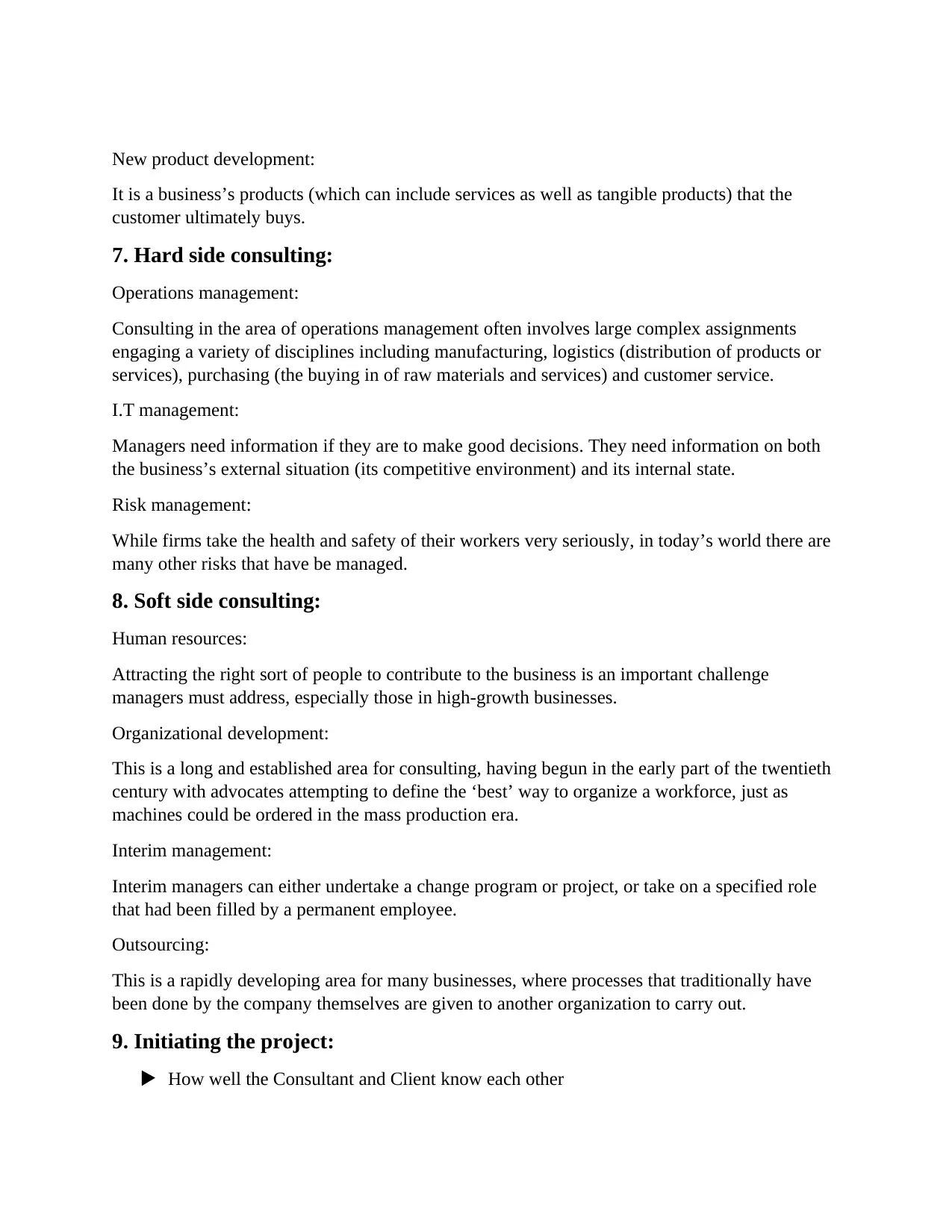
New product development:
It is a business’s products (which can include services as well as tangible products) that the
customer ultimately buys.
7. Hard side consulting:
Operations management:
Consulting in the area of operations management often involves large complex assignments
engaging a variety of disciplines including manufacturing, logistics (distribution of products or
services), purchasing (the buying in of raw materials and services) and customer service.
I.T management:
Managers need information if they are to make good decisions. They need information on both
the business’s external situation (its competitive environment) and its internal state.
Risk management:
While firms take the health and safety of their workers very seriously, in today’s world there are
many other risks that have be managed.
8. Soft side consulting:
Human resources:
Attracting the right sort of people to contribute to the business is an important challenge
managers must address, especially those in high-growth businesses.
Organizational development:
This is a long and established area for consulting, having begun in the early part of the twentieth
century with advocates attempting to define the ‘best’ way to organize a workforce, just as
machines could be ordered in the mass production era.
Interim management:
Interim managers can either undertake a change program or project, or take on a specified role
that had been filled by a permanent employee.
Outsourcing:
This is a rapidly developing area for many businesses, where processes that traditionally have
been done by the company themselves are given to another organization to carry out.
9. Initiating the project:
How well the Consultant and Client know each other
It is a business’s products (which can include services as well as tangible products) that the
customer ultimately buys.
7. Hard side consulting:
Operations management:
Consulting in the area of operations management often involves large complex assignments
engaging a variety of disciplines including manufacturing, logistics (distribution of products or
services), purchasing (the buying in of raw materials and services) and customer service.
I.T management:
Managers need information if they are to make good decisions. They need information on both
the business’s external situation (its competitive environment) and its internal state.
Risk management:
While firms take the health and safety of their workers very seriously, in today’s world there are
many other risks that have be managed.
8. Soft side consulting:
Human resources:
Attracting the right sort of people to contribute to the business is an important challenge
managers must address, especially those in high-growth businesses.
Organizational development:
This is a long and established area for consulting, having begun in the early part of the twentieth
century with advocates attempting to define the ‘best’ way to organize a workforce, just as
machines could be ordered in the mass production era.
Interim management:
Interim managers can either undertake a change program or project, or take on a specified role
that had been filled by a permanent employee.
Outsourcing:
This is a rapidly developing area for many businesses, where processes that traditionally have
been done by the company themselves are given to another organization to carry out.
9. Initiating the project:
How well the Consultant and Client know each other
⊘ This is a preview!⊘
Do you want full access?
Subscribe today to unlock all pages.

Trusted by 1+ million students worldwide
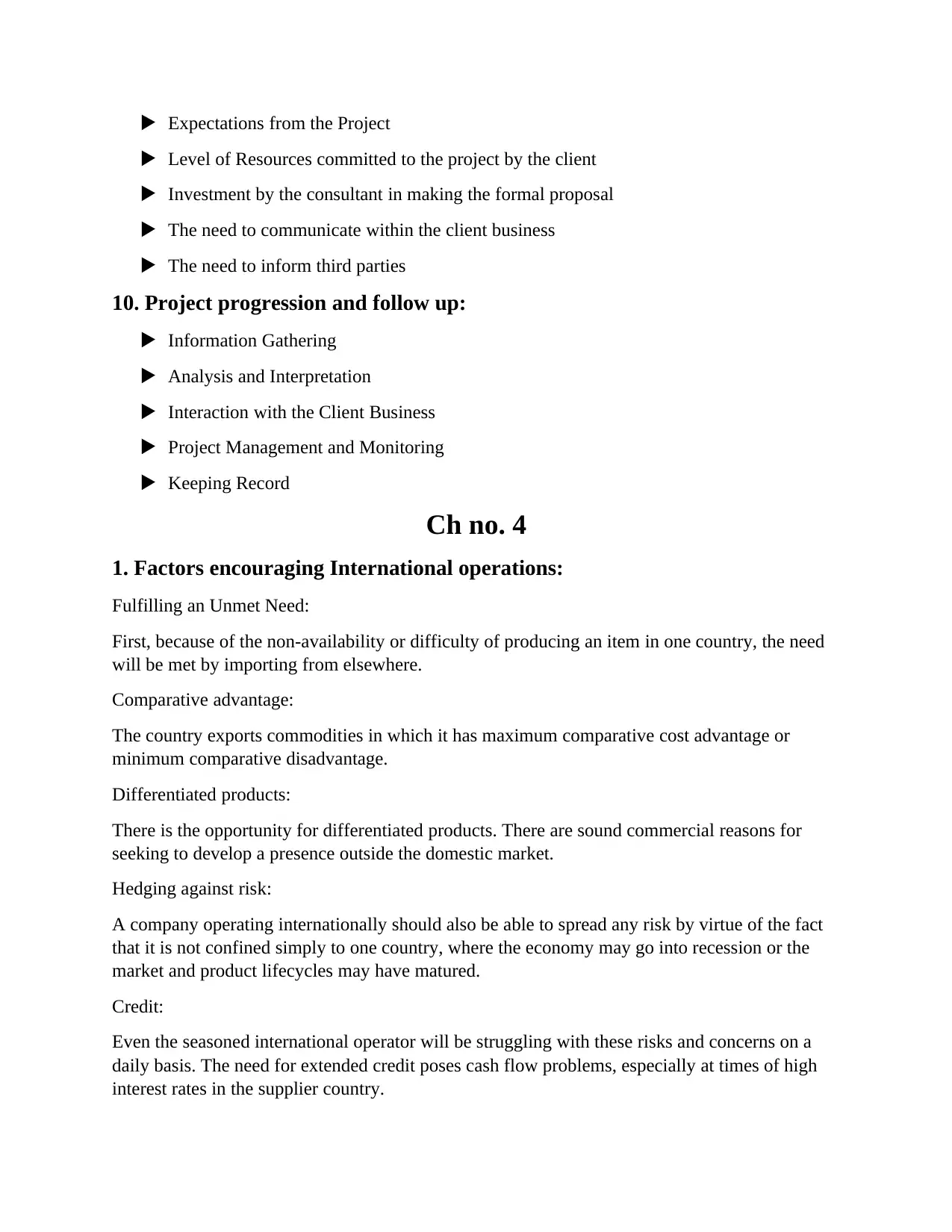
Expectations from the Project
Level of Resources committed to the project by the client
Investment by the consultant in making the formal proposal
The need to communicate within the client business
The need to inform third parties
10. Project progression and follow up:
Information Gathering
Analysis and Interpretation
Interaction with the Client Business
Project Management and Monitoring
Keeping Record
Ch no. 4
1. Factors encouraging International operations:
Fulfilling an Unmet Need:
First, because of the non-availability or difficulty of producing an item in one country, the need
will be met by importing from elsewhere.
Comparative advantage:
The country exports commodities in which it has maximum comparative cost advantage or
minimum comparative disadvantage.
Differentiated products:
There is the opportunity for differentiated products. There are sound commercial reasons for
seeking to develop a presence outside the domestic market.
Hedging against risk:
A company operating internationally should also be able to spread any risk by virtue of the fact
that it is not confined simply to one country, where the economy may go into recession or the
market and product lifecycles may have matured.
Credit:
Even the seasoned international operator will be struggling with these risks and concerns on a
daily basis. The need for extended credit poses cash flow problems, especially at times of high
interest rates in the supplier country.
Level of Resources committed to the project by the client
Investment by the consultant in making the formal proposal
The need to communicate within the client business
The need to inform third parties
10. Project progression and follow up:
Information Gathering
Analysis and Interpretation
Interaction with the Client Business
Project Management and Monitoring
Keeping Record
Ch no. 4
1. Factors encouraging International operations:
Fulfilling an Unmet Need:
First, because of the non-availability or difficulty of producing an item in one country, the need
will be met by importing from elsewhere.
Comparative advantage:
The country exports commodities in which it has maximum comparative cost advantage or
minimum comparative disadvantage.
Differentiated products:
There is the opportunity for differentiated products. There are sound commercial reasons for
seeking to develop a presence outside the domestic market.
Hedging against risk:
A company operating internationally should also be able to spread any risk by virtue of the fact
that it is not confined simply to one country, where the economy may go into recession or the
market and product lifecycles may have matured.
Credit:
Even the seasoned international operator will be struggling with these risks and concerns on a
daily basis. The need for extended credit poses cash flow problems, especially at times of high
interest rates in the supplier country.
Paraphrase This Document
Need a fresh take? Get an instant paraphrase of this document with our AI Paraphraser
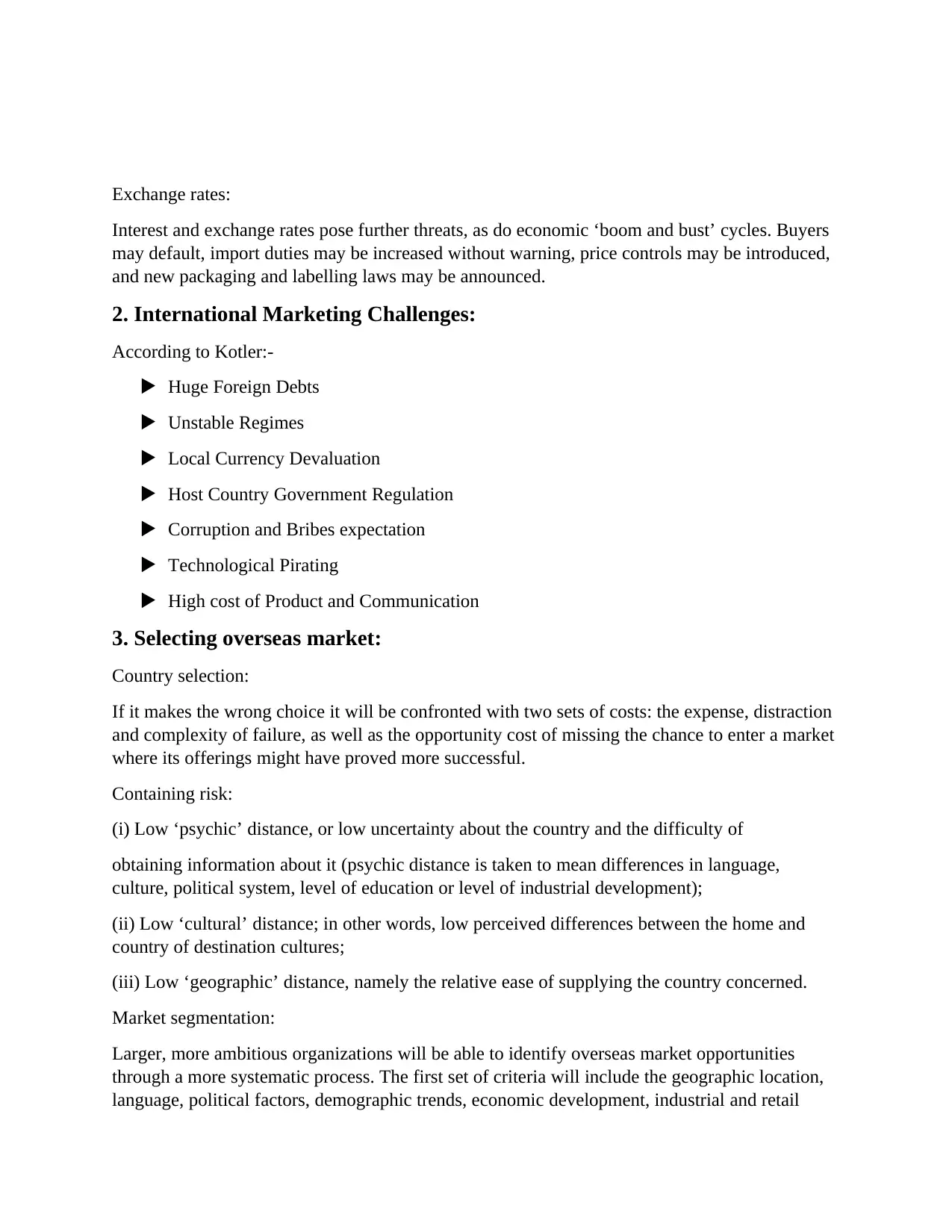
Exchange rates:
Interest and exchange rates pose further threats, as do economic ‘boom and bust’ cycles. Buyers
may default, import duties may be increased without warning, price controls may be introduced,
and new packaging and labelling laws may be announced.
2. International Marketing Challenges:
According to Kotler:-
Huge Foreign Debts
Unstable Regimes
Local Currency Devaluation
Host Country Government Regulation
Corruption and Bribes expectation
Technological Pirating
High cost of Product and Communication
3. Selecting overseas market:
Country selection:
If it makes the wrong choice it will be confronted with two sets of costs: the expense, distraction
and complexity of failure, as well as the opportunity cost of missing the chance to enter a market
where its offerings might have proved more successful.
Containing risk:
(i) Low ‘psychic’ distance, or low uncertainty about the country and the difficulty of
obtaining information about it (psychic distance is taken to mean differences in language,
culture, political system, level of education or level of industrial development);
(ii) Low ‘cultural’ distance; in other words, low perceived differences between the home and
country of destination cultures;
(iii) Low ‘geographic’ distance, namely the relative ease of supplying the country concerned.
Market segmentation:
Larger, more ambitious organizations will be able to identify overseas market opportunities
through a more systematic process. The first set of criteria will include the geographic location,
language, political factors, demographic trends, economic development, industrial and retail
Interest and exchange rates pose further threats, as do economic ‘boom and bust’ cycles. Buyers
may default, import duties may be increased without warning, price controls may be introduced,
and new packaging and labelling laws may be announced.
2. International Marketing Challenges:
According to Kotler:-
Huge Foreign Debts
Unstable Regimes
Local Currency Devaluation
Host Country Government Regulation
Corruption and Bribes expectation
Technological Pirating
High cost of Product and Communication
3. Selecting overseas market:
Country selection:
If it makes the wrong choice it will be confronted with two sets of costs: the expense, distraction
and complexity of failure, as well as the opportunity cost of missing the chance to enter a market
where its offerings might have proved more successful.
Containing risk:
(i) Low ‘psychic’ distance, or low uncertainty about the country and the difficulty of
obtaining information about it (psychic distance is taken to mean differences in language,
culture, political system, level of education or level of industrial development);
(ii) Low ‘cultural’ distance; in other words, low perceived differences between the home and
country of destination cultures;
(iii) Low ‘geographic’ distance, namely the relative ease of supplying the country concerned.
Market segmentation:
Larger, more ambitious organizations will be able to identify overseas market opportunities
through a more systematic process. The first set of criteria will include the geographic location,
language, political factors, demographic trends, economic development, industrial and retail
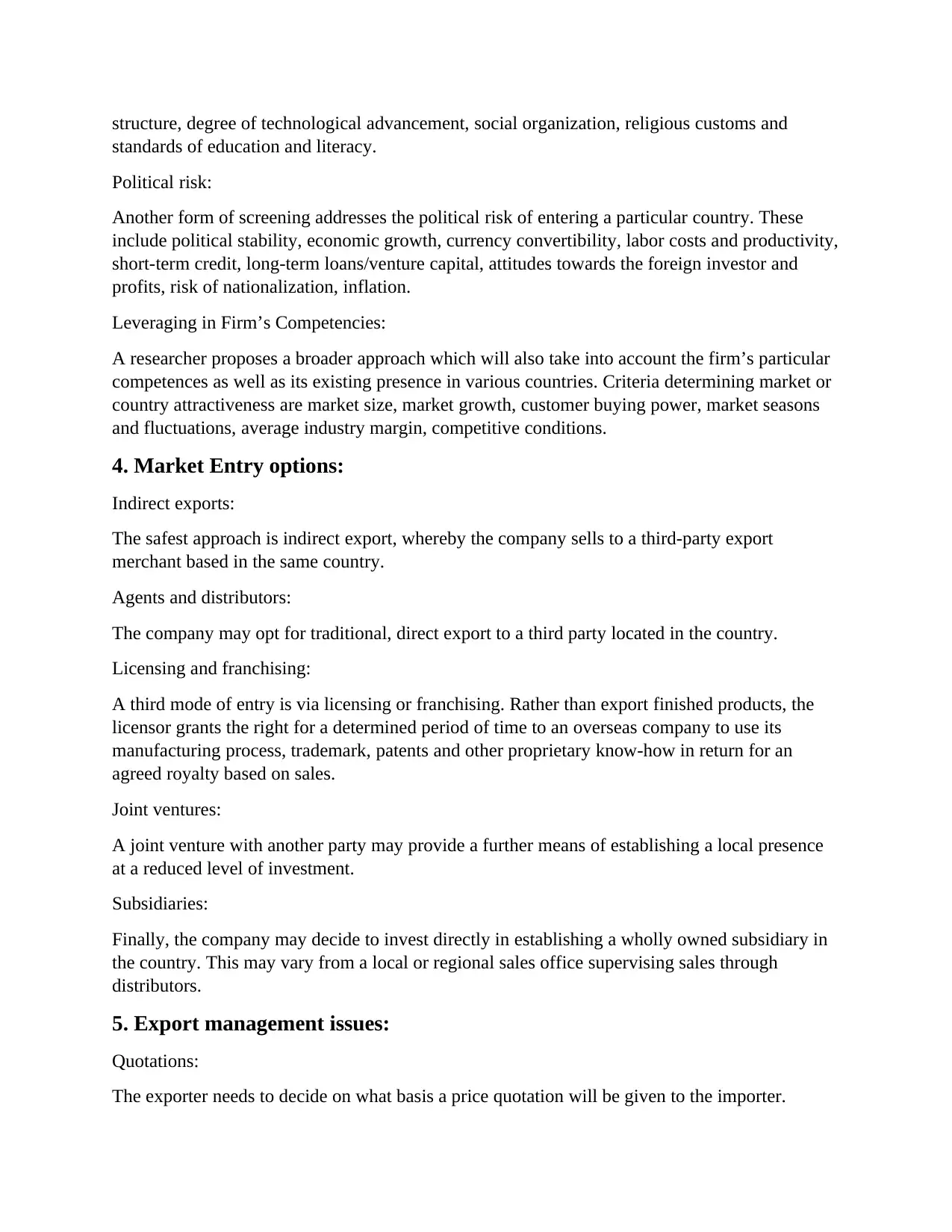
structure, degree of technological advancement, social organization, religious customs and
standards of education and literacy.
Political risk:
Another form of screening addresses the political risk of entering a particular country. These
include political stability, economic growth, currency convertibility, labor costs and productivity,
short-term credit, long-term loans/venture capital, attitudes towards the foreign investor and
profits, risk of nationalization, inflation.
Leveraging in Firm’s Competencies:
A researcher proposes a broader approach which will also take into account the firm’s particular
competences as well as its existing presence in various countries. Criteria determining market or
country attractiveness are market size, market growth, customer buying power, market seasons
and fluctuations, average industry margin, competitive conditions.
4. Market Entry options:
Indirect exports:
The safest approach is indirect export, whereby the company sells to a third-party export
merchant based in the same country.
Agents and distributors:
The company may opt for traditional, direct export to a third party located in the country.
Licensing and franchising:
A third mode of entry is via licensing or franchising. Rather than export finished products, the
licensor grants the right for a determined period of time to an overseas company to use its
manufacturing process, trademark, patents and other proprietary know-how in return for an
agreed royalty based on sales.
Joint ventures:
A joint venture with another party may provide a further means of establishing a local presence
at a reduced level of investment.
Subsidiaries:
Finally, the company may decide to invest directly in establishing a wholly owned subsidiary in
the country. This may vary from a local or regional sales office supervising sales through
distributors.
5. Export management issues:
Quotations:
The exporter needs to decide on what basis a price quotation will be given to the importer.
standards of education and literacy.
Political risk:
Another form of screening addresses the political risk of entering a particular country. These
include political stability, economic growth, currency convertibility, labor costs and productivity,
short-term credit, long-term loans/venture capital, attitudes towards the foreign investor and
profits, risk of nationalization, inflation.
Leveraging in Firm’s Competencies:
A researcher proposes a broader approach which will also take into account the firm’s particular
competences as well as its existing presence in various countries. Criteria determining market or
country attractiveness are market size, market growth, customer buying power, market seasons
and fluctuations, average industry margin, competitive conditions.
4. Market Entry options:
Indirect exports:
The safest approach is indirect export, whereby the company sells to a third-party export
merchant based in the same country.
Agents and distributors:
The company may opt for traditional, direct export to a third party located in the country.
Licensing and franchising:
A third mode of entry is via licensing or franchising. Rather than export finished products, the
licensor grants the right for a determined period of time to an overseas company to use its
manufacturing process, trademark, patents and other proprietary know-how in return for an
agreed royalty based on sales.
Joint ventures:
A joint venture with another party may provide a further means of establishing a local presence
at a reduced level of investment.
Subsidiaries:
Finally, the company may decide to invest directly in establishing a wholly owned subsidiary in
the country. This may vary from a local or regional sales office supervising sales through
distributors.
5. Export management issues:
Quotations:
The exporter needs to decide on what basis a price quotation will be given to the importer.
⊘ This is a preview!⊘
Do you want full access?
Subscribe today to unlock all pages.

Trusted by 1+ million students worldwide
1 out of 14
Related Documents
Your All-in-One AI-Powered Toolkit for Academic Success.
+13062052269
info@desklib.com
Available 24*7 on WhatsApp / Email
![[object Object]](/_next/static/media/star-bottom.7253800d.svg)
Unlock your academic potential
Copyright © 2020–2025 A2Z Services. All Rights Reserved. Developed and managed by ZUCOL.




